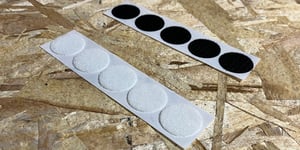Things were going excellent with your new converter until you reviewed the quote they sent you. Now, you’re stunned– why is there such a hefty price tag on tooling?
It’s a common misconception that flexible material converters keep infinite die cutting tools on-site, ready to go for your project. However, rather than having the tool ready, we use your drawing to order a custom-made die cutting tool for each new part.
Out of the 80,000+ part designs Strouse has worked with over the years, many have become valuable die cutting tools thanks to the hard work of our suppliers and engineers.
Once you’ve learned more about your tooling cost, you’ll better understand why you’re paying for partial tooling charges.
3 Factors that Make Up the Cost of Die Cut Tooling
Tools are an essential part of any die cutting process, and given the nature of converting, each die is a custom tool used to cut shapes out of your chosen material.
It takes an exact die cutting tool to build your part, so your converters are tasked with buying new dies for nearly every project.
FACTOR #1: INITIAL COST
When you send us your drawing, we don’t automatically forward it to the die cutting tool manufacturer. Instead, our engineers make slight alterations to your sketch, so the tool is built to cut more accurately when the material is running through the rotary die cut press.
Then, after we’ve optimized your drawing for a rotary press, we use it to order a custom die cutting tool. If it doesn’t cut to dimension properly, we’re open to buying a new tool that will cut to size.
Similar to car maintenance, a die cutting tool is never fully finished being paid off. Die cutting tools wear out over time and need replacement, cleaning, and storage, which Strouse ensures.
There are two main situations where we don’t always cover re-tooling costs: Choosing highly abrasive materials and making changes to your design.
FACTOR #2: ABRASIVE MATERIALS
Cutting sandpaper with scissors causes the blades to sharpen and erode over time. Similarly, cutting abrasive materials will damage the edges of a die cutting tool.
Any material with a “hard” or “rough” component or coating could be considered an abrasive material. Choosing highly abrasive material will cause your die cutting tool to erode quickly, leading to more frequent re-tooling and replacements over time.
Examples of materials that are often abrasive include but aren’t limited to:
- Ceramics
- Metals
- White inks (titanium dioxide pigment)
- Carbon fiber
- Thicker paper
Abrasive materials reduce the typical die life, but because we don’t know the rate at which the die cutting tool will wear out completely, it’s difficult to predict how long each tool will last. The life of the tool depends on the type of material, the type of cuts, and the speed at which you’re cutting. At most, your converter can give you a rough estimate for replacement based on how long it’ll be able to cut material.
Abrasive materials aren’t the only challenging material to process; if you’re choosing material, ask which materials you can use to make die cuts.
In cases where you choose a highly abrasive material, Strouse might only cover some of your inevitable re-tooling costs.
FACTOR #3: DESIGN CHANGES
The final circumstance in which could end up having to pay for die cut tooling is if you change your part design after purchasing the initial die cutting tool.
Design changes include altering the measurements, tolerances, or materials of your part in any way.
Minor alterations or material changes might allow us to continue using the same tool, but for considerable changes, we won’t be able to re-tool to the modifications in design.
If we don’t cover re-tooling for design changes, why do we still need to discuss your tolerances? It’s simple: tight tolerances are more difficult to engineer, and your new die could cost more than your original die.
Each die cutting tool is custom for the part we’re building and replacing them can become expensive. If you can avoid it, buying multiple dies is ill-advised.
What Else Do I Need to Know About Die Cut Tooling?
What else do I need to know about tooling, and how do I mitigate the strain of wearing out tools?
Luckily for you, if your project deals with small quantities of parts, or the materials are laser-friendly, you can avoid tooling altogether. Other options like flatbed laser or flash cut parts are available as non-tool options for low quantities depending on the complexity of the materials.
As your converter, we lay out the tooling cost without trying to hide it within the cost of your die cut part. If you’re unsure how much your die cut tooling will cost, request a quote today:






